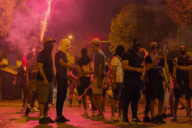Amnesty International has launched a video in which different European citizens and refugees look at each other’s eyes for 4 minutes to see how they react. Several NGOs have organized different campaigns to bring closer the refugees’ reality and to raise awareness among the European society.
Two benches facing each other in an empty room. That’s the scene laid out by Amnesty International for their new campaign, where refugees and European citizens look at each other for four minutes. The experiment show their reactions while holding their looks.
“When I was looking at her, I was trying to figure out what could I tell of what she had lived”, says Lee, from the United Kingdom, about her meeting with Mariam, from Syria.
The NGO declared that they are spontaneous situations, non-planned and without actors. The refugees participating have been in the EU “less than a year”, they add.
The ad is inspired in a psychological experiment of Arthur Aron who, 20 years ago, claimed that holding visual contact for 4 minutes could bring people closer.
Although the biggest asylum crisis since the Second World War (approximately 60 million people have currently left their homes) has had smaller repercussions in Europe than in some other countries, the number of asylum seekers has increased in comparison with the last years. Thus, the NGOs have understood the need of raising awareness about their situation.
Save the Children has launched two campaigns, with a gap of two years, that show a European girl living in an imaginary war on European soil. The images show the experiences of thousands of Syrian children: the bombs, leaving their homes, losing their families, the abandonment… This time all these experiences are happening “here”.
The second video shows the vulnerability refugees experience in the EU: their stays in detention facilities, he police charges and the closing of borders, among others.
Unicef took it one step further, making people believe that they had won a trip. But, when they explained to the winners the trip conditions, they realized that it was not what they expected.
Doctors Without Borders turned to virtual reality in a series of 360º videos in which the viewer can “talk” to a young refugee in a wheelchair or see the arrival of a boat filled with refugees to the Aegean sea coast.
Finally, CEAR (the Spanish Commission for Refugees) asks the European leaders “Who is giving less?”, in a striking spot in which it shows the “auction” of refugees that has taken place within the EU, when the European countries rejected their refugees’ quotas while thousands of people drowned every day in the Mediterranean. The reality has changed a little: finally the EU accepted the quotas, but they are not accomplishing it, and people continue to die in the Mediterranean.














No Comments